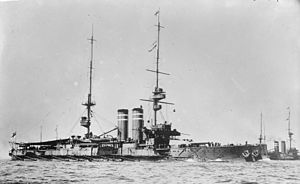
Back Třída King Edward VII Czech King-Edward-VII-Klasse German Clase King Edward VII Spanish King Edward VII -luokka Finnish Classe King Edward VII French אוניות המערכה מסדרת קינג אדוארד השביעי HE Classe King Edward VII Italian キング・エドワード7世級戦艦 Japanese Classe King Edward VII Portuguese Броненосцы типа «Кинг Эдуард VII» Russian
 HMS King Edward VII, lead ship of the King Edward VII class.
| |
| Class overview | |
|---|---|
| Name | King Edward VII class |
| Builders | Chatham Dockyard, Devonport Dockyard, John Brown, Fairfield, Portsmouth Dockyard, Vickers |
| Operators | |
| Preceded by | Duncan class |
| Succeeded by | Swiftsure class |
| Built | 1902–1906 |
| In service | 1905–1921 |
| Completed | 8 |
| Lost | 2 |
| Retired | 6 |
| General characteristics | |
| Class and type | Pre-dreadnought battleship |
| Displacement | |
| Length | 453 ft 9 in (138.3 m) (loa) |
| Beam | 75 ft (22.9 m) |
| Draught | 25 ft 8 in (7.82 m) |
| Installed power |
|
| Propulsion | |
| Speed | 18.5 knots (34.3 km/h; 21.3 mph) |
| Complement | 777 |
| Armament |
|
| Armour | |
The King Edward VII class was a class of eight pre-dreadnought battleships launched by the Royal Navy between 1903 and 1905. The class comprised King Edward VII, the lead ship, Commonwealth, Hindustan, Britannia, Dominion, New Zealand, Africa, and Hibernia. They marked the first major development of the basic pre-dreadnought type that had been developed with the Majestic type of the mid-1890s, all of which had been designed by the Director of Naval Construction, William Henry White, with the primary innovation being the adoption of a heavy secondary battery of four 9.2-inch (234 mm) guns to supplement the standard main battery of four 12 in (305 mm) guns. The King Edward VIIs were among the last pre-dreadnoughts built for the Royal Navy before the construction and launch of the revolutionary battleship HMS Dreadnought in 1906, which immediately rendered them obsolescent.
The ships served with the Atlantic Fleet from 1905 to 1907, when they were transferred to the Channel Fleet, though this service lasted only until 1908–1909, when they were reassigned to the Home Fleet. During this period, King Edward VII served as fleet flagship as a result of a request from her namesake that she always serve as such. Africa and Hibernia were involved with experiments with seaplanes in 1912, and that year all members of the class were assigned to the 3rd Battle Squadron of the Home Fleet and were later sent to the Mediterranean Sea to respond to the First Balkan War.
By the outbreak of the First World War in August 1914, the King Edward VIIs were sent to the Grand Fleet to support the Northern Patrol and to conduct sweeps in the North Sea for German warships, though they never saw combat. In January 1916, King Edward VII struck a German naval mine and sank, though her crew was safely evacuated. By mid-1916, the surviving ships were no longer suitable for front-line fleet service, and so they were dispersed to other tasks, including coastal defence with the Nore Command and for operations in the Gallipoli Campaign. Africa was sent to the Atlantic Patrol in 1917 and was later stricken with Spanish flu, and Britannia was torpedoed and sunk by a German U-boat two days before the end of the war, one of the last British warships to be sunk in the conflict. The surviving members of the class were all sold for scrap in the early 1920s.